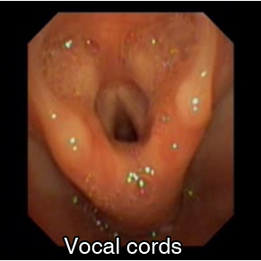Vocal cord paralysis information
Vocal cord paralysis is the 2nd most common congenital condition affecting a newborn larynx. It should be dignosed early for its effective management.
The voice box or the larynx has 2 vocal cords or folds that are stretched across and attached between the laryngeal cartilages. They sit at the top of the lower airways. Their main function is to prevent the passage of food and liquids into the windpipe and protect the lungs during feeding. They vibrate, during the outflow of air from the lungs, to produce voice. The vocal cords spread apart (abduction) during respiration and come closer (adduction) during speech. When vocal cords are weakened or paralysed (partially or totally), these functions get affected.
There are muscles that co-ordinate the opening and the closing of the vocal cords. These movements are controlled by the recurrent laryngeal nerve (RLN) - a branch of the tenth cranial nerve (vagus).

Causes
There are several causes which can be responsible for causing weakness of vocal cords. These could be different in adults and children.
- Children could be born with weakened cords at birth (congenital paralysis). If both cords are affected, it causes severe breathing difficulties. It is the vagus nerve and its branch - the recurrent laryngeal nerve (RLN) that helps move the vocal cords. These nerves could be compressed or crushed by a tumor, mass in the neck or the chest. The nerves could be traumatised during an accident or surgery done for other causes in the neck and chest (typically surgeries on the heart and lungs). There could be a viral infection of the nerve. Sometimes, there is no detected cause.
- In adults, thyoid / neck surgeries, neck trauma and accidents, strangulations may cause direct damage to the RLN. Paralysis may be caused secondary to cancer of the larynx, esophagus (food pipe), thyroid or lungs. In these cases, there is either direct infiltration or compression of the nerve.
Signs and symptoms
These depend on whether one side or both sides are affected.
- Unilateral: When only one vocal cord is affected, the child will have a hoarse voice and breathy cry. They may have passage of food and liquids into the windpipe instead of the food pipe (aspiration), thus having an increased risk of developing lung infections.
- Bilateral: Children with both vocal cords paralysed have respiratory and feeding difficulties. They have stridor with noisy breathing and make high-pitched musical sounds. Non-functioning vocal cords do not block the feeds which go past them and enter the lungs. This is called bronchoaspiration, and risks development of lung infections.
A bilateral paralysis may be associated with other congenital anomalies and require tracheostomy in 50% cases.
Cancer patients will have associated symptoms related to the tumor itself.
Diagnosis
The diagnosis includes clinical examination combined with endoscopic evaluation. A good clinical history leads to diagnosis in majority of the cases. Objective voice analysis can be done in adults by a speech pathologist.
Nasal flexible endoscopy is a procedure where a telescope is passed into one nostril and down the back of the throat, to look at vocal cords movement. A stroboscopy gives more detailed analysis of the vocal folds.
An MRI / CT scan will be organised to evaluate the exact cause of the paralysis. Further, a panendoscopy (microlaryngoscopy, tracheo-bronchoscopy, esophagoscopy) is performed under general anesthesia to look at the the entire aero-digestive tract.
Treatment
The treatment will depend on the patient’s age and cause of the paralysis.
With only one vocal cord affected, the patients do not need immediate treatment. The voice can be corrected with speech therapy, and includes various exerecises to train and strengthen the vocal cord muscles. The aim is to help the opposite normal cord and other laryngeal structures to compensate the functions lost due to the paralysed cord.
If there is bronchoaspiration and crippling voice change, the paralysed cord could be medialised (brought in the midline to make contact with the opposite cord) by an operation – thyroplasty or endoscopic cord medialisation procedures. The procedure is done under either local or general anaesthesia to reposition the vocal cords (using prosthesis or injecting bio-acceptable material into the vocal cords). Following the operation, the patient will need to have additional voice therapy to strengthen the vocal cords.
Both vocal cord paralysis presents with severe breathing difficulty and is an emergency. The patient may require an urgent tracheostomy (opening through the skin into the windpipe). Larynx opening procedures (arytenoidectomy, posterior cordotomy, cord lateralisation) are used to eventually decannulate and remove the tracheostomy. These are invasive procedures for the larynx and best avoided in very small children.
For patients staying outside Switzerland, a systematic plan of follow up is prepared taking into consideration the long distance of travel and individual country insurance policies.



